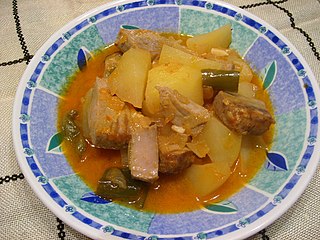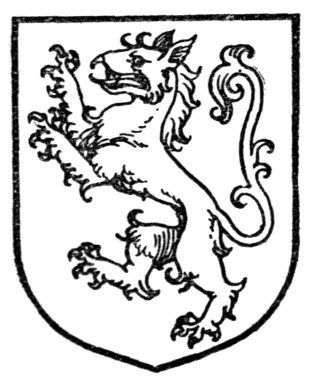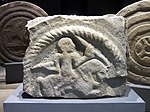
Cantabria is an autonomous community and province in northern Spain with Santander as its capital city. It is called a comunidad histórica, a historic community, in its current Statute of Autonomy. It is bordered on the east by the Basque autonomous community, on the south by Castile and León, on the west by the Principality of Asturias, and on the north by the Cantabrian Sea.

The Curupira is a mythological creature present in Tupi-Guarani myths, such as those found in Paraguay, the Amazonia of Brasil and the northeast of Argentina.

The Cantabrian Mountains or Cantabrian Range are one of the main systems of mountain ranges in Spain. They stretch for over 300 km (180 miles) across northern Spain, from the western limit of the Pyrenees to the Galician Massif in Galicia, along the coast of the Cantabrian Sea. Their easternmost end meets the Sistema Ibérico.

Tuna pot, marmitako in Basque Country and marmita, marmite or sorropotún in Cantabria is a fish stew that was eaten on tuna fishing boats in the Cantabrian Sea. Today it is a simple dish with tuna, potatoes, onions, peppers, and tomatoes.

Cantabrian cuisine is the cuisine from Cantabria, an autonomous community in northern Spain. It includes seafood from the Cantabrian Sea, salmon and trout from the upper basins of the rivers, vegetables and dairy products from the valleys, and veal and game from the Cantabrian mountains.
The Nuberu, Nubero (Castilian) or Nubeiro (Galician) -literally "The Clouder"- is a character of Asturian, Cantabrian, Galician and northern Castilian mythology. According to Asturian mythology, the Nuberu, is the divinity of clouds and storms.

Cuélebre (Asturian) or Culebre (Cantabrian), is a giant winged serpent-dragon of the Asturian and Cantabrian mythology, that lives in a cave, guards treasures and keeps anjanas as prisoners. Although they are immortal, the cuélebre age, and their scales become thick and impenetrable, and bat wings grow in their bodies. They must eventually flee Asturias and fly to the Mar Cuajada, a paradise located beyond the sea.

The Cantabria autonomous football team is the regional football team for Cantabria, Spain. They are not affiliated with FIFA or UEFA and therefore are only allowed to play friendly matches.
Cantabrian is a group of dialects belonging to Astur-Leonese. It is indigenous to the territories in and surrounding the Autonomous Community of Cantabria, in Northern Spain.

Cantabrian mythology refers to the myths, teachings and legends of the Cantabri, a pre-Roman Celtic people of the north coastal region of Iberia (Spain). Over time, Cantabrian mythology was likely diluted by Celtic mythology and Roman mythology with some original meanings lost. Later, the ascendancy of Christendom absorbed or ended the pagan rites of Cantabrian, Celtic and Roman mythology leading to a syncretism. Some relics of Cantabrian mythology remain.
The cuegle is a monster in Cantabrian folklore. Walking on two legs and roughly humanoid in shape, it is believed to have black skin, a long beard, grey hair, three arms without hands or fingers, five rows of teeth, a single stubby horn and three eyes in its head: one yellow, one red, and one blue. It is said to have great strength despite its small size. The cuegle attacks people and livestock, and is reputed to steal babies from the cradle. It may be protected against by placing oak or holly leaves, which it finds repulsive, in the cradle.
In Cantabrian mythology, a ramidreju is a creature said to inhabit the mountains and forests of Cantabria in northern Spain. This animal, which resembles a weasel, is born once every hundred years from a weasel or a marten. These mythological creatures have a very long body, like a snake, and their fur is slightly green-colored. Its eyes are yellow and its nose is like that of a hog, which it uses to dig very deep holes. Ramidrejus are a very sought-after animal in Cantabrian folklore because their fur heals every sickness and the animal has a strong desire for gold.

The Ojáncanu is a cyclops found in Cantabrian mythology, and is an embodiment of cruelty and brutality. It appears as a 10 to 20 foot tall giant with superhuman strength, with hands and feet that contain ten digits each, and two rows of teeth. With a very wild and beast-like temperament, it sports a long mane of red hair, and just as much facial hair, with both nearly reaching to the ground. Apparently the easiest way of killing an Ojancanu is to pull the single white hair found in its mess of a beard. The females are virtually the same, though without the presence of a beard. However, the females have long drooping breasts that like their male counterpart's hair, reach the ground. In order to run, they must carry their breasts behind their shoulders. The strangest thing about these peculiar cyclopean species is their reproduction process. Instead of mating, when an old Ojancanu dies, the others distribute the insides and bury the corpse under an oak or yew tree. He is constantly doing evil deeds such as pulling up rocks, destroying huts and trees, and blocking water sources. He fights Cantabrian brown bears and Tudanca bulls, and always wins. He only fears the Anjanas, the good Cantabrian fairies.

The Anjana are one of the best-known fairies of Cantabrian mythology. These female fairy creatures foil the cruel and ruthless Ojáncanu. In most stories, they are the good fairies of Cantabria, generous and protective of all people. Their depiction in the Cantabrian mythology is reminiscent of the lamias in ancient Greek mythology, as well as the xanas in Asturias, the janas in León, and the lamias in Basque Country, the latter without the zoomorphic appearance.

The Cantabrian Water Dog is a landrace breed of dog developed in the coast of Cantabria, northern Spain, as an assistant to fishermen. The breed was classified and recognized by the Breeds Committee of the Spanish Ministry of Environment on 22 March 2011. It is recognised by the Royal Canine Society of Spain as a variety of the Spanish water dog.

Tyger, also known as heraldic tiger or tygre, is an imaginary beast used as a charge in heraldry.
The ventolines are creatures of Cantabrian mythology. They are spirits of the air who help those who sail on the sea.












